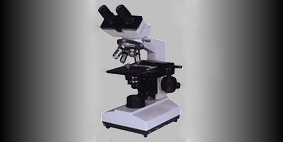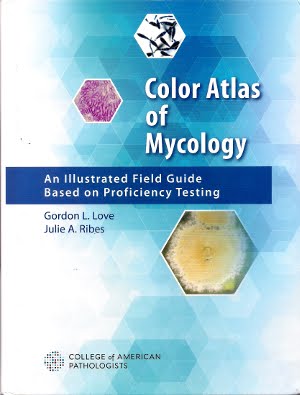Paecilomyces variotii (Fungus)
Ecology: Ubiquitous – worldwide distribution found in soil and decaying vegetation. May be isolated as an environmental or laboratory contaminant.
Macroscopic Morphology: Moderately rapid growth on SAB reaching about 7 to 8 mm after a week. Colonies are tan to yellowish-brown (mustard) in colour, darkening slightly as they mature. Texture is powdery to floccose. Reverse may appear darker.
P.variotii on SAB at 1 week showing a yellowish-brown colour. Several failed attempts were made to produce an isolated colony growing centered on the plate. The conidia are so loosely bound that even the closing of the incubator door dispersed maturing conidia to further seed the media.

Microscopic Morphology: Produces hyaline, septate hyphae.
Conidiophores bear supporting cells which branch verticillately, each producing some 2 to 7 phialides about 3.5 µm to 6.5 µm in width and 150 µm in length. Phialides are cylindrical or ellipsoidal in shape which widen from the base then taper to a thin neck somewhat resembling a bowling pin. Conidia are subspherical or ellipsoidal in shape, smooth walled and about 2-4 µm by 3-5 µm in size. Conidia generally arise in long divergent chains. Thick-walled intercalary or terminal subglobose chamydospores (4-8 µm) may be produced.
* * *
All photos that follow were taken with the
Leica DMD-108 Digital Microscope. Differences in structural size at same magnification may be due to cropping of photos.
* * *
P.variotii (LPCB X250)
P.variotii (LPCB X400)
 P.variotii
P.variotii (LPCB X400)

Ditto
 P.variotii
P.variotii (LPCB X1000)
P.variotii (LPCB X1000)
(A few more pretty pictures just to get a better feel of what this organisms looks like)
P.variotii (LPCB X1000)
 P.variotii
P.variotii (LPCB X1000)
 P.variotii
P.variotii (LPCB X1000 + 10X digital zoom)
Note the cylindrical 'bowling pin' shaped phailides - more thin and delicate than those of Penicillium species.

Ditto
 P.variotti
P.variotti showing phailides and disrupted conida. Conidia generally are produced in longer chains however they are so loosely bound that the are easily disrupted even in spite of my use of a slide culture and working very delicately. (LPCB X1000)
P.variotii showing phialides bearing conidia at left and chamydospores on right (LPCB X1000)

Okay, just a couple more photos...
 P.variotii
P.variotii (LPCB X1000 + X10 digital zoom)
Subspherical to elipsoid conidia scrambled above phailides attached to supporting cells on conidiophore extending from septate hyaphae.

Paecilomyces variotii (LPCB X1000)
(Intended as 1024 X 768 wallpaper)
Physiology: Paecilomyces variotii is thermophillic and can grow well up to 50oC and possibly higher.
Pathology: Another opportunistic fungus which has been rarely implicated in human disease, however may pose increase risk to immunocompromised individuals. Has been implicated in prosthetic valve endocarditis, osteomyelitis, endophthalmitis, otitis media, pneumonia and cellulitis.
* * *

 P.variotti showing phailides and disrupted conida. Conidia generally are produced in longer chains however they are so loosely bound that the are easily disrupted even in spite of my use of a slide culture and working very delicately. (LPCB X1000)
P.variotti showing phailides and disrupted conida. Conidia generally are produced in longer chains however they are so loosely bound that the are easily disrupted even in spite of my use of a slide culture and working very delicately. (LPCB X1000)















.jpg)























